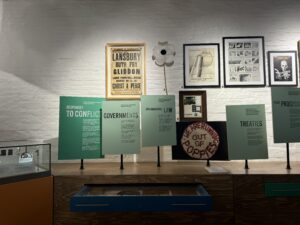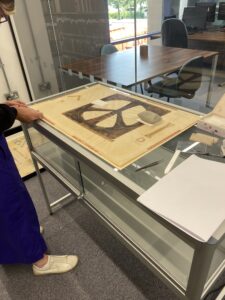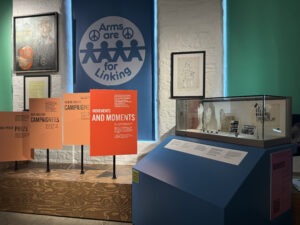As war is a truth of common life, a museum on the subject of peace is always going to be relevant.
If I try to think of what war looks like, I can quite easily paint a picture in my mind – of uniforms and combat, of news coverage and battle lines, of hardship and lives ruined. The way the world is today means we’re surrounded by images and objects of conflict. There are plenty of museums dedicated to wars and weapons too. But to try and summon up an image of peace is a bit more difficult, perhaps more abstract.
Now The Peace Museum has opened in its new home in Saltaire, offering historical reminders of what peacebuilding has looked like in the past as well as asking us what we can do to make peace succeed today.

The Peace Museum. Photo provided by The Peace Museum.
To visit a museum devoted just to the topic of peace and to immersive ourselves in objects relating to the subject is a unique experience. The Peace Museum’s new permanent exhibition – which will be supplemented by temporary exhibitions – doesn’t seek to persuade us all to become pacifists, as some might expect. Instead, it seeks to display objects and stories from the past that might inspire each of us to take a little of the story of peace away with us.
Indeed, it’s right that a peace museum doesn’t have a blood-curdling battle cry as its call to action. Instead, it offers us an insightful and thought-provoking experience, reminding us that the potential for a peaceful world resides not only in governments and systems but in all of us.
So what’s in a peace museum? What makes an object of peace?
To start with are things that were intentionally made to further the message of peace in our world. There are protest placards that have been marched in the street, pin badges from campaigns, printed materials, a Nobel Peace prize award and plenty of doves. Perhaps one of the most striking is a very early sketch of the Campaign for Nuclear Disarmament logo where you can see the artist working with the letters CND. It’s a privilege to get up close to something in the making that is now recognisable the world over. As powerful as these objects are, maybe none of them are surprising.

Designed in 1958 by Gerald Holtom, on loan from the Commonweal Collection. Photo provided by The Peace Museum.
More incongruous and also intriguing are those objects which weren’t made with a peaceful endeavour in mind, the items that were never intended to end up in a peace museum. Near the start of the exhibition, a wall of green security fencing from Greenham Common hangs on the wall, not only a representation of a world that tries to keep people out, but a reminder of the important role women have played in the fight for peace. And there are some domestic items from Nagasaki, Japan that morphed in the explosive heat of an atomic explosion. In a way, these seemingly ‘normal’ objects are all the more powerful – suggesting that when momentous happenings occur, anything we touch in our daily lives can take on another life.
There’s a parallel between the objects on display and the kinds of people whose stories are told in the museum. Again, there are personalities present that you might expect including officials and politicians, peace campaigners and activists. Of course, you can hear Nelson Mandela’s voice and the chants of the protesting crowds. You can also listen to everyday people and everyday voices, including those of Yorkshire, recorded locally. And by pressing a button you can hear the word ‘peace’ translated into a few dozen languages – paix, paz, mir, salam, fred and more.
As well as pressing buttons, visitors are encouraged to engage with the subject in addition to just reading or looking at objects. You can respond to the questions in the displays, take a moment to make a banner, stop to be part of a workshop, or follow them online. The opening temporary exhibition is called What does peace mean to you? and invites visitors to investigate a map of Bradford, filled with tiny scrolls that people have responded to.

The Peace Museum. Photo provided by The Peace Museum.
Through its carefully curated exhibition, The Peace Museum provides a range of narratives and perspectives to visitors. There are official stories and those from the mainstream media as well as, importantly, the unofficial, the stories of everyday lives that have been affected by, and rallied against, conflict. The museum is a reminder that we don’t need to leave peace-building to others, but that peace starts with us, the people.
Main image: Designed in 1958 by Gerald Holtom, on loan from the Commonweal Collection. Photo provided by The Peace Museum.
The Peace Museum is open Wednesday to Sunday, 10am to 4pm. It is located on the third floor of Salts Mill, Saltaire, West Yorkshire. For more information, click here.








